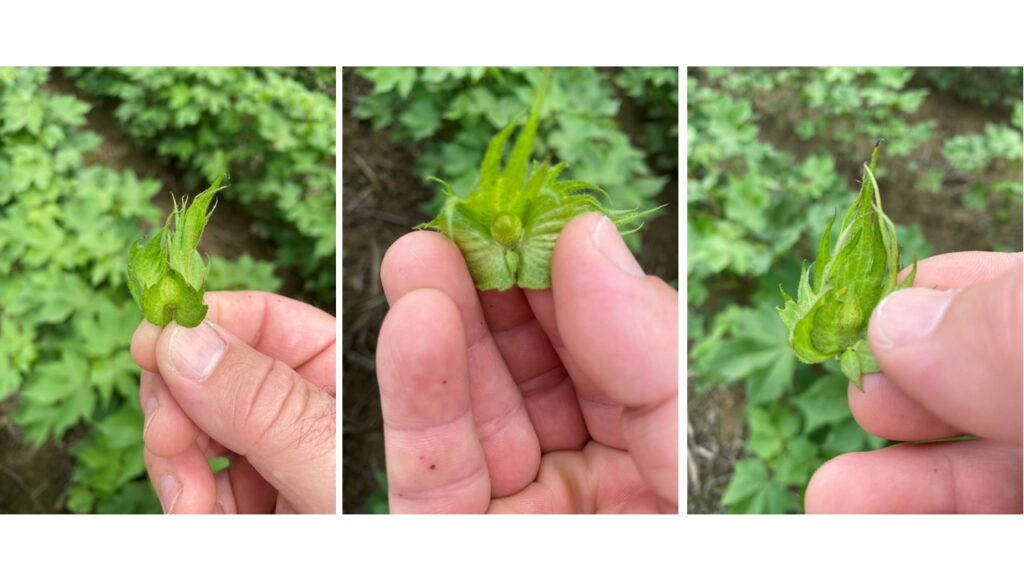4-Bract Squares Observed (Collins, Edmisten & Reisig)
go.ncsu.edu/readext?874170
en Español / em Português
El inglés es el idioma de control de esta página. En la medida en que haya algún conflicto entre la traducción al inglés y la traducción, el inglés prevalece.
Al hacer clic en el enlace de traducción se activa un servicio de traducción gratuito para convertir la página al español. Al igual que con cualquier traducción por Internet, la conversión no es sensible al contexto y puede que no traduzca el texto en su significado original. NC State Extension no garantiza la exactitud del texto traducido. Por favor, tenga en cuenta que algunas aplicaciones y/o servicios pueden no funcionar como se espera cuando se traducen.
Português
Inglês é o idioma de controle desta página. Na medida que haja algum conflito entre o texto original em Inglês e a tradução, o Inglês prevalece.
Ao clicar no link de tradução, um serviço gratuito de tradução será ativado para converter a página para o Português. Como em qualquer tradução pela internet, a conversão não é sensivel ao contexto e pode não ocorrer a tradução para o significado orginal. O serviço de Extensão da Carolina do Norte (NC State Extension) não garante a exatidão do texto traduzido. Por favor, observe que algumas funções ou serviços podem não funcionar como esperado após a tradução.
English
English is the controlling language of this page. To the extent there is any conflict between the English text and the translation, English controls.
Clicking on the translation link activates a free translation service to convert the page to Spanish. As with any Internet translation, the conversion is not context-sensitive and may not translate the text to its original meaning. NC State Extension does not guarantee the accuracy of the translated text. Please note that some applications and/or services may not function as expected when translated.
Collapse ▲We have observed multiple cases of 4-bract squares in NC cotton over the past few days. 4-bract squares are a phenomenon that isn’t completely understood, but is commonly associated with high temperatures early in the season. With temperatures reaching the mid to high 90’s during May and June, this isn’t necessarily a surprise. We expect more reports of 4-bract squares over the next week, as it is likely widespread. 4-bract squares can be both obvious and inconspicuous as illustrated in the images below.
4-bract squares will nearly always abort soon after blooming occurs. It will be important to document the frequency of 4-bract squares from field to field as this might affect boll retention percentages during the bloom period, which could influence insect management. Documenting the number or frequency of 4-bract squares will help us understand how much retention, or fruit shed, may be affected by insects versus the mere presence of 4-bract squares. For example, tarnished plant bug or bollworm feeding can lead to square abortion. Weekly scouting for insects can help distinguish whether square abortion was due to pest pressure or 4-bract squares. Hopefully, the number of 4-bract squares will be minimal, but it will be important to look for, and document, their presence when walking fields.
The amount of 4-bract squares may change the way we manage the crop for the remainder of the season. If such squares are rather common, naturally, fruit retention during the bloom period will be lower. This may shift the boll distribution curve to higher nodes on the plant, and could force us to rely on bolls on upper nodes to make our harvestable crop. When fruit retention is lower than normal during bloom, this could spur growth. The first instinct is the be aggressive with PGRs, however, given the hot dry conditions we’ve experienced thus far, we should consider letting the plant growth for a while, in order to form new, upper fruiting sites. Once plant height approaches a critical point of being too tall, we should be aggressive with PGRs at that time. Again, most cotton is rather short, or too short, at this point, due to hot, dry conditions, therefore, let it grow for now, but be ready to manage growth later.
Additionally, shifting the harvestable portion of our crop to higher nodes on the plant may also prolong the period in which we need to scout for, and protect them from insects, including Lygus, caterpillars, and stinkbugs. Keep these in mind when making scouting plans for the remainder of the season, but for now, try to document the presence and frequency of 4-bract squares so you have an idea of what to expect later.




